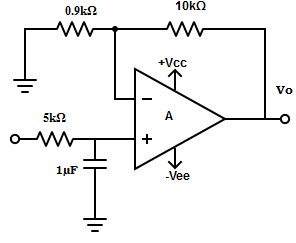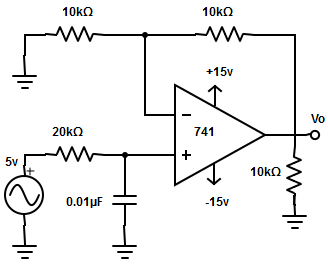11. Which filter performs exactly the opposite of the band-pass filter?
A. Band-reject filter
B. Band-stop filter
C. Band-elimination filter
D. All of the mentioned
12. Given the lower and higher cut-off frequency of a band-pass filter are 2.5kHz and 10kHz. Determine its bandwidth.
A. 750 Hz
B. 7500 Hz
C. 75000 Hz
D. None of the mentioned
13. In which filter the output and input voltages are equal in amplitude for all frequencies?
A. All-pass filter
B. High pass filter
C. Low pass filter
D. All of the mentioned
14. The gain of the first order low pass filter
A. Increases at the rate 20dB/decade
B. Increases at the rate 40dB/decade
C. Decreases at the rate 20dB/decade
D. Decreases at the rate 40dB/decade
15. Which among the following has the best stop band response?
A. Butterworth filter
B. Chebyshev filter
C. Cauer filter
D. All of the mentioned
16. Determine the order of filter used, when the gain increases at the rate of 60dB/decade on the stopband.
A. Second-order low pass filter
B. Third-order High pass filter
C. First-order low pass filter
D. None of the mentioned
17. Name the filter that has two stopbands?
A. Band-pass filter
B. Low pass filter
C. High pass filter
D. Band-reject filter
18. The frequency response of the filter in the stopband.
A. Decreases with increase in frequency
B. Increase with an increase in frequency
C. Decreases with a decrease in frequency
D. All of the above
19. Find the voltage across the capacitor in the given circuit

A. VO= Vin/(1+0.0314jf)
B. VO= Vin×(1+0.0314jf)
C. VO= Vin+0.0314jf/(1+jf)
D. None of the mentioned
20. Find the complex equation for the gain of the first order low pass Butterworth filter as a function of frequency.
A. AF/[1+j(f/fH)].
B. AF/√ [1+j(f/fH)2].
C. AF×[1+j(f/fH)].
D. None of the mentioned
21. Compute the passband gain and high cut-off frequency for the first order high pass filter.

A. AF=11, fH=796.18Hz
B. AF=10, fH=796.18Hz
C. AF=2, fH=796.18Hz
D. AF=3, fH=796.18Hz
22. Match the gain of the filter with the frequencies in the low pass filter
| Frequency | Gain of the filter |
| 1. f H | i. VO/Vin ≅ AF/√2 |
| 2. f=fH | ii. VO/Vin ≤ AF |
| 3. f>fH | iii. VO/Vin ≅ AF |
A.1-i,2-ii,3-iii
B.1-ii,2-iii,3-i
C.1-iii,2-ii,3-i
D.1-iii,2-i,3-ii
24. Determine the gain of the first order low pass filter if the phase angle is 59.77o and the passband gain is 7.
A. 3.5
B. 7
C. 12
D. 1.71
25. In a low pass Butterworth filter, the condition at which f=fH is called
A. Cut-off frequency
B. Break frequency
C. Corner frequency
D. All of the mentioned
26. Find the High cut-off frequency if the passband gain of a filter is 10.
A. 70.7Hz
B. 7.07kHz
C. 7.07Hz
D. 707Hz
27. To change the high cutoff frequency of a filter. It is multiplied by R or C by a ratio of the original cut-off frequency known as
A. Gain scaling
B. Frequency scaling
C. Magnitude scaling
D. Phase scaling
